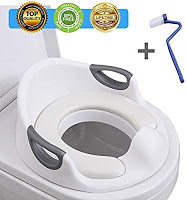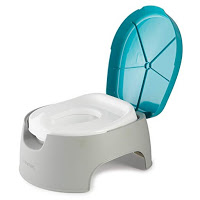Occupational therapy professionals work with clients of all ages and abilities on toileting and hygiene. That’s why this resource on special needs toilet training seats is so important. In therapy sessions, a skilled assessment of the whole individual can indicate a need for postural modifications to support motor skill needs. When it comes to potty training and toileting in general, there is a LOT of information out there. And, if you ask around for suggestions for the best potty training seats, you will probably get a variety of answers.
Some of these seats will help with independent perineal care, too because of the positioning and stability added for balance. Potty training supports like handrails, grab bars, and guards can help with the hygiene aspect of toileting.
Special Needs Toilet Training Seats
It can be overwhelming to weed through all of the potty seats out there on the market and in the local box store toddler aisle. The difficulty compounds when you consider potty training with special needs children.
Today, I wanted to pull together a list of kids toilet seats out there on the market that are perfect for special needs kids, as well as typically developing kids. Why? Because so often, a few simple changes with positioning, balance, and stability can be the tool to help kids feel more comfortable, confident during the toileting process.
Adding a stable support at the feet, back, or bottom can help a child to relax so they can toilet.
These potty training chairs help address the underlying needs that kids might struggle with when it comes to potty training. These potty training seats and supports can be the tools needed to address a variety of underlying needs when it comes to getting started with potty training.
Here’s the thing: it can be difficult to make suggestions or come up with a comprehensive list that covers ALL of the special needs out there. (That’s where your occupational therapy evaluation or equipment analysis will come into play!)
BUT, I can definitely address some of the more common potty training seats out on the market and address the underlying areas that they can address and hopefully target a best fit.
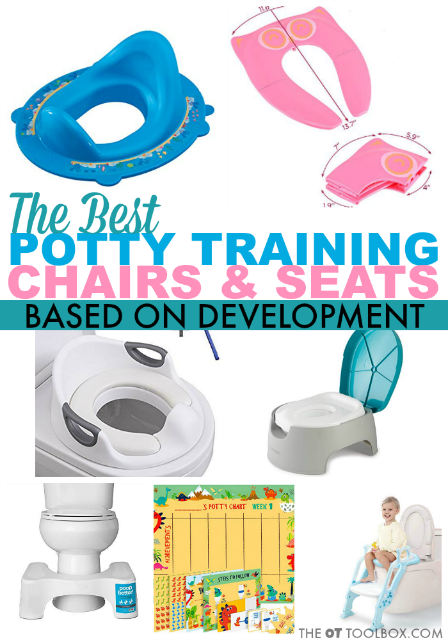
Potty Training Seats are Not One-Size Fits All!
Let’s face it. There is no one-size-fits-all approach when it comes to potty training. Because of the vast differences in in kids development, interests, motivation, physical or special needs, potty training can be a challenge to know where to start.
This list is hopefully a start for addressing some of the areas kids need for successful potty training.
Amazon affiliate links are included below.
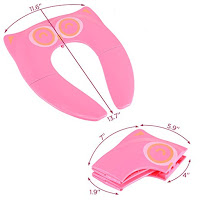
Portable Seat– (affiliate link) This type of seat is great for kids who need a smaller opening on the toilet. Kids of all needs benefit from a larger seat area when first potty training. This one is nice because it can be carried from place to place when on the go outside of the home. Just fold it up and place in it’s carrying bag. Using a portable seat can make it easy to add interests when beginning potty training. Add interests such as special toys and items to make sitting motivating.
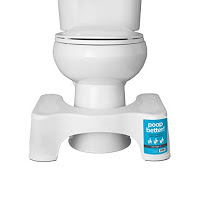
Squatty Potty– (affiliate link) The squatty potty is a helpful way to provide a more stable base of support while sitting on the toilet seat. Kids can place their feet on the support that curves around the toilet base and improve balance while sitting. This base of support can help kids who need extra support or have balance needs.
The Step and Go stool (affiliate link) is another, more inexpensive option. Adding a supportive base can help calm nerves of unsupported sitting. Children can use a wider base of support with this type of stool.
Potty Training Chart– (affiliate link) While this isn’t a potty training seat, a training chart can be used to promote extended sitting on a potty chair, and to allow kids the ability to build up patience to sit and wait on a potty chair.
Starting out by using a potty training chart to encourage kids just to go to and sit on the potty seat is a great start for younger kids or those who need to accommodate for sensory needs.
A visual tool such as a potty training chart can be a practical way to reinforce individual skills that make up the process of toilet training. The nice thing about toilet training charts is that they can be individualized, based on the child’s needs.
Some kids with special needs or sensory needs may be afraid of walking into the bathroom. A sticker chart can be one strategy to address that aspect given various modifications or activities that can help address needs.
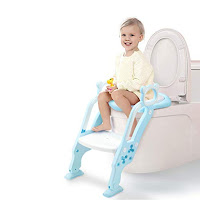
Step Stool with Handles– (affiliate link) Having a handle can help little ones who struggle with balance or feeling unstable when sitting on a regular sized toilet seat. This one has a step stool that provides a base of support through the feet.
Toilet Seat with Pee Guard– (affiliate link) This seat insert has handles and slight curvature to the sides of the toilet seat ring, providing support and a sense of stability when seated on a regular size toilet. The urine guard is helpful for both boys and girls.
Three-in-one Potty Training Seat– (affiliate link) As a mom of four, this 3-in-one potty training seat is a favorite. It goes with kids from the toddler stage when a smaller, floor potty chair is helpful in training. The ring insert can then be used when transitioning to a regular sized toilet. Finally, the seat forms a step stool for using either on the toilet or when washing hands. This is a convenient toilet training seat for families!
A lower toilet position is closer to the ground and fits a smaller bottom. This helps with transition to a regular size toilet and allows for comfort and confidence in young children. This potty training system is great for the child who appreciates consistency.
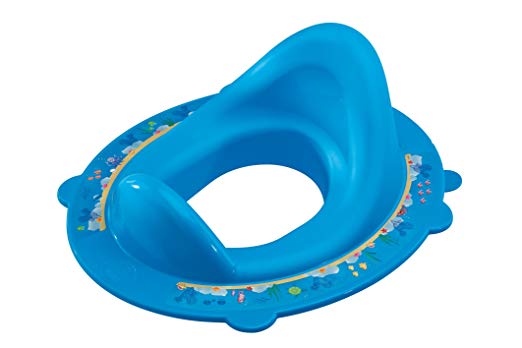
Ring Reducer– (affiliate link) There are many styles of toilet seat ring reducers out there and they serve a great purpose; to reduce the size of the opening on the toilet seat, allowing for small kids to feel more safe and secure when sitting on the toilet. This is a good transition seat to a regular sized toilet. For kids who struggle with coordination and balance, this ring reducer can be just the ticket to potty training success.
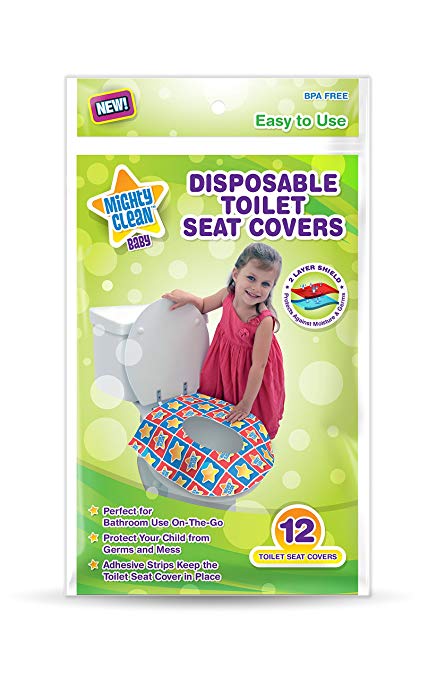
Disposable Seat Covers– (affiliate link) These seat covers are convenient for kids who tend to grab the toilet seat when sitting on a regular-sized toilet. When out and about in the community, it can be helpful for some kids to use a seat cover that is more effective than just using toilet paper. Some of our kiddos can’t tolerate sitting without holding onto the seat or just can’t follow the directions to “not hold onto the seat”.
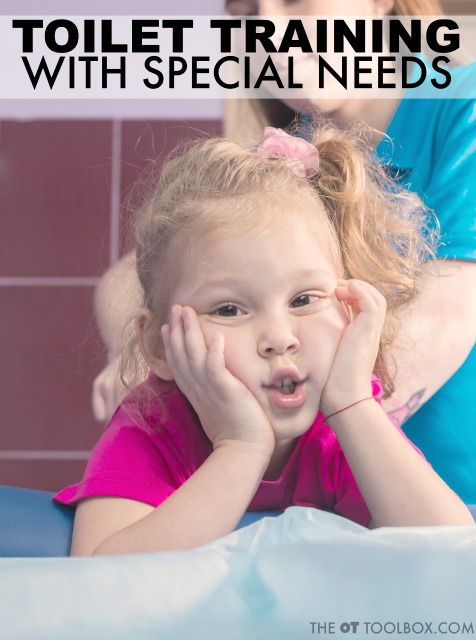
Physical Limitations and Special Needs Toilet Training
While these potty training seat options just cover the surface of potty training, it’s important to remember to consider the underlying and developmental aspects of potty training.
The therapist’s perspective can play an important part in identifying any developmental or transitioning needs when it comes to potty training. While there are many more specific tools that can be used with special needs toilet training as well as typically developing kids, these are just some of the basics.
Remember that there truly is not a one-size-fits-all aspect for toileting. Some of our kids with more physical special needs or developmental considerations may benefit from a more extensive and supportive seating system.
That’s where the occupational therapist comes into play with identifying needs and tools that will promote independence and function.
There are many considerations that should be addressed when it comes to seating and toilet seats. First and foremost is the safe positioning of the individual on the toilet. Other considerations, depending on the special diagnosis may include:
- reflex development and maturation
- muscle tone
- range of motion
- balance
- motor skills
- attention span
- motor planning
- visual perceptual skills
- postural reactions
- joint tightness
- eye mobility
- cognitive considerations
- weakness
- sensory processing challenges
- self-concept
- body awareness
In the book, The Toilet Training Book: A Developmental Take on Potty Training for Kids of all Abilities, we cover more on special diagnoses and potty training, including strategies and tips for individuals with cerebral palsy, Spina Bifida, trauma, Traumatic Brain Injury, ADHD, Autism, and other general considerations.
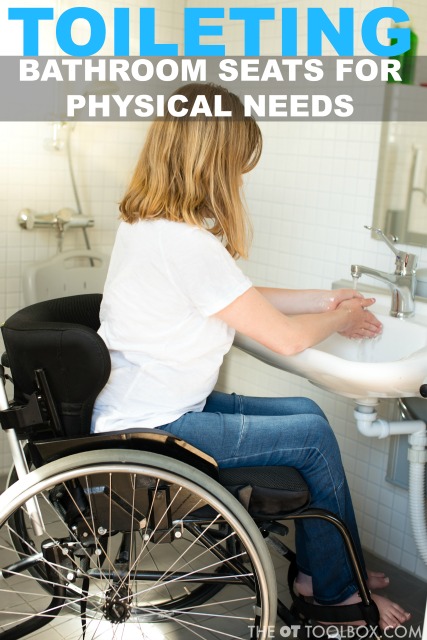
Potty Training Seats for Physical Needs
Toileting Seat System- There are many toileting systems on the market that address physical needs. Seating systems are intended to promote positioning, safety, mobility, transfers, function, and quality of life of the individual. Look for a system that meets the budget and can efficiently accommodate various needs such as toileting, showering/bathing, hygiene, etc.
Systems can come with a variety of adjustments and supports. Consider the need or use of the following supports:
- Headrest
- Backrest
- Armrests
- Lateral back supports
- Harness
- Seat belt
- Tray
- Anterior support
- Hip guides
- Abductor
- Urine deflector or guard
- Calf supports
- Lower extremity lateral supports
- Ankle straps
- Footrest
- Tilt in space (backward/forward)
- Recline
- Height adjustments
- Push handles (for caregiver support)
- Wheeled base
- Molded and Foam cushions
- Pan/adaptability for use over a toilet or as a stand-alone toilet chair
Support Station for Toileting- A standing support station can be used in assisted hygiene or assisted toileting. The standing station can be a support to transfers and can be beneficial to clothing management, self-care, skin care, and undergarment changing.
The support station is a helpful tool for improving function and dignity of clients as can perform aspects of toileting, as well as participate in self-care. This is a means for reducing diaper use as well, further improving dignity.
Additionally, support stations are a tool for improved safety of caregivers. When clients stand at a standing support frame, they are truly building strength, endurance and self-care skills in a natural manner within the occupation of toileting.
Wiping after toileting and special Potty seating
When it comes to pericare, there are things to consider with the various special needs toileting systems.
- Can the child maintain their balance while reaching for toilet paper?
- Can the child weight bear or shift their weight from side to side or forward in order to wipe?
- Can the child reach around their body to wipe?
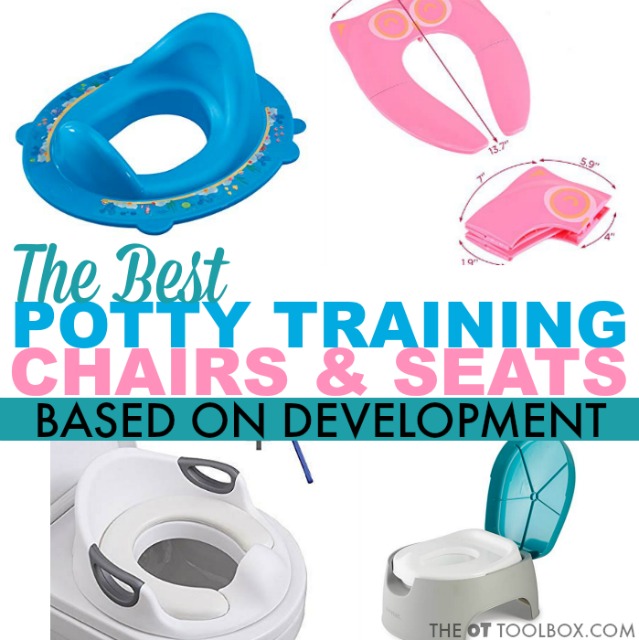
For More information on Potty Training
Watch for information coming soon to this space on the new Toilet Training Book! It’s about to be released and is your go-to resource on potty training based on development and individualized needs.
This book was created by occupational therapists and physical therapists who are experts in the field of child development, sensory processing, motor skills, and function. Need more information and real strategies to improve potty training success? Want insider tips and tools from the occupational therapist’s and physical therapist’s perspectives? The Toilet Training Book is here!
Potty Training Help
Tackling potty training is a challenge for all kids! What if you had the inside scoop on development in your back pocket?
What if you had the know-how of occupational therapists and physical therapists with DECADES of experience to guide you?
The Toilet Training Book offers a developmental look at potty training for kids of ALL needs.
- This digital e-book is a deal of a resource at $19.99
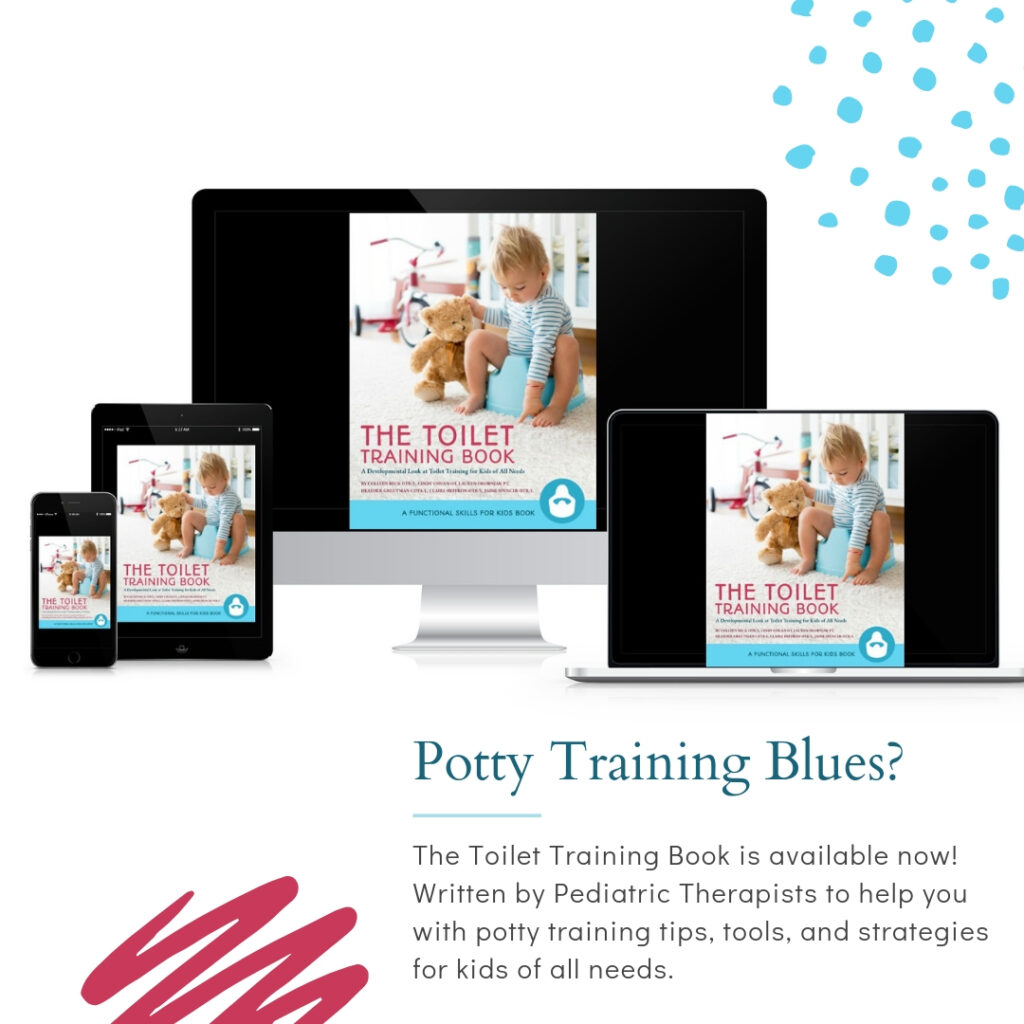
The Toileting Book is a comprehensive resource covering every aspect of toilet training.
Details about The Toileting Book:
- Written by a team of experienced pediatric occupational therapists and physical therapists with decades of experience
- Packed with information on toilet training readiness and achievement of toileting success
- Includes Toilet Training Guides for special populations (children with fine or gross motor needs, behavioral or cognitive challenges, physical disabilities, etc.) including Sensory Processing Disorder, Trauma-Informed Needs, Autism Spectrum Disorder, Cerebral Palsy, Spina Bifida, Spinal Cord Injuries
- Provides information on interoception and the role this sensory system plays in potty training
- Discusses common toileting equipment and special needs toileting tools
- Includes tips and suggestions for individualized toilet training
This book is available in digital, e-book format AND in a physical, soft-cover book format.
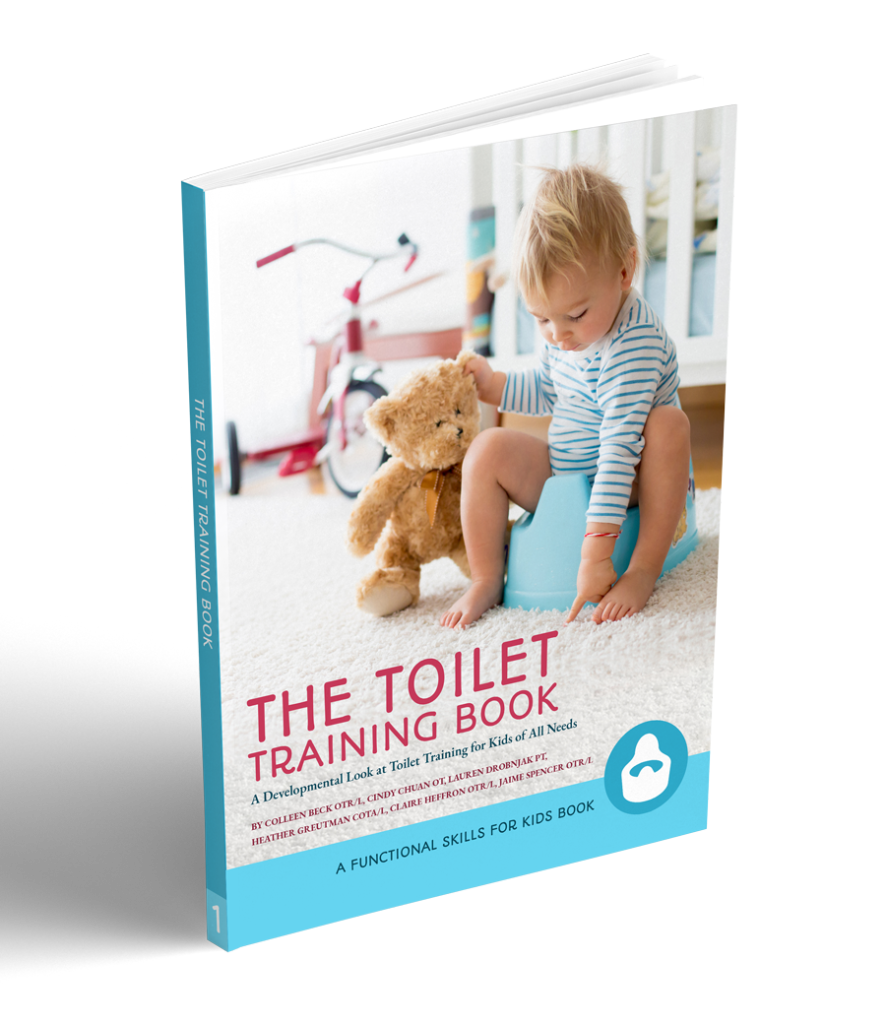
The Toilet Training Book- the potty training resource you need!


